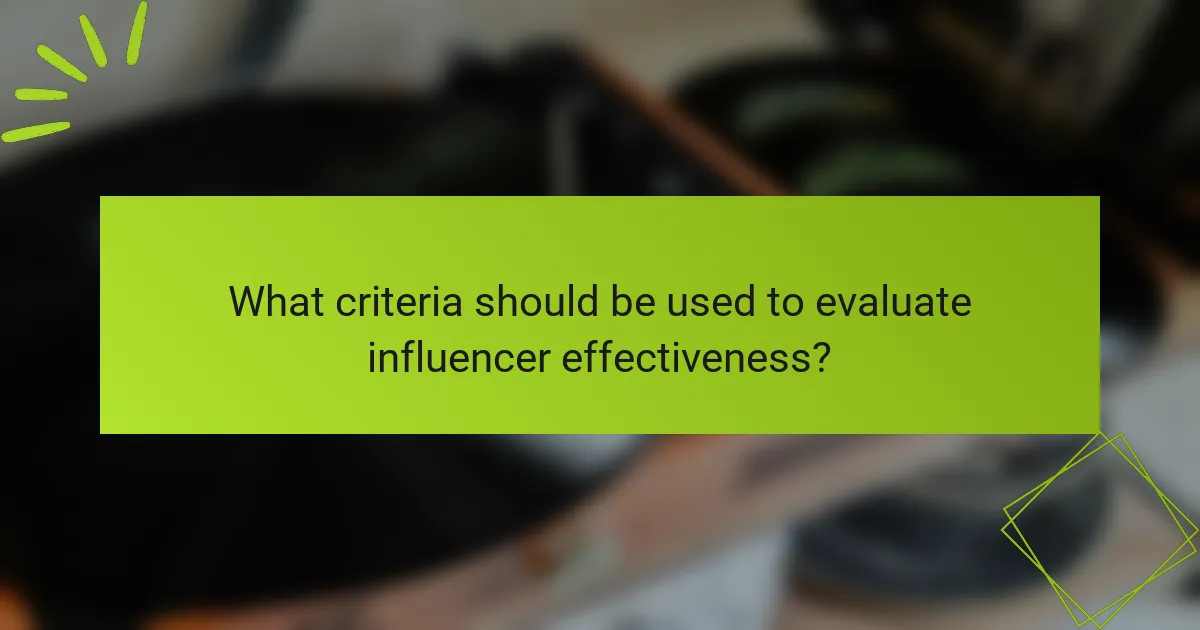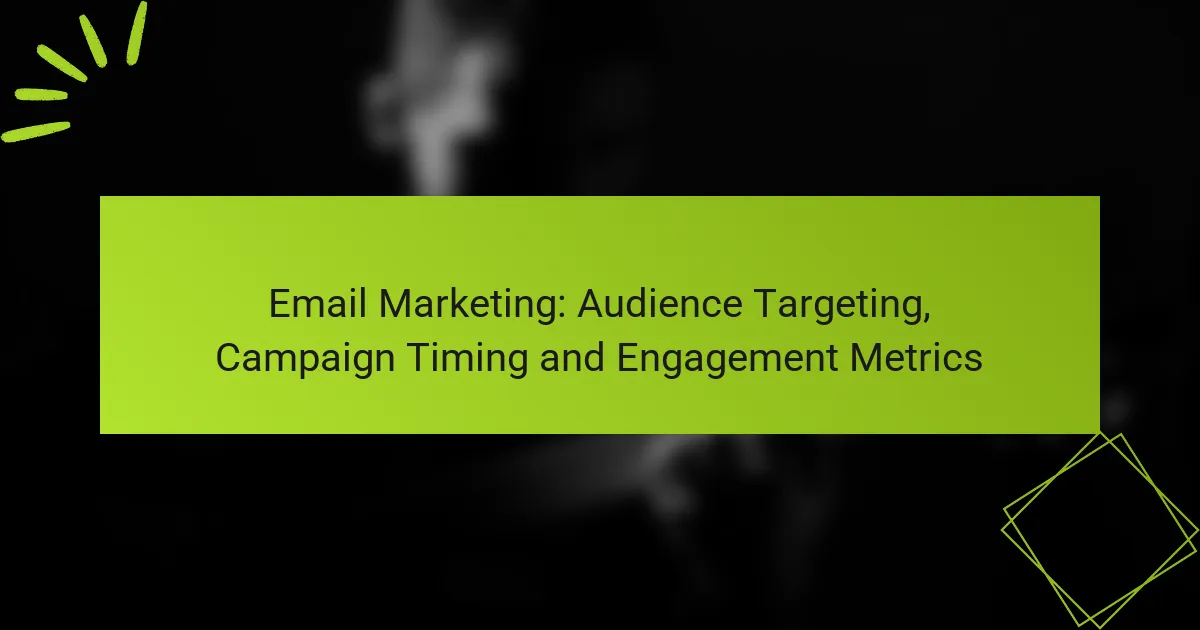Influencer marketing has emerged as a powerful strategy for brands seeking to connect with their target audiences through trusted voices. By carefully selecting influencers whose values and audiences align with their own, brands can foster authentic partnerships that enhance visibility and credibility. The effectiveness of these collaborations hinges on the trust that influencers have built with their followers, making it essential for brands to prioritize genuine relationships in their marketing efforts.

How to choose the right influencers for marketing campaigns?
Choosing the right influencers for marketing campaigns involves identifying individuals whose audience aligns with your target market and whose values resonate with your brand. Consider factors such as engagement rates, audience demographics, and content style to ensure a successful partnership.
Micro-influencers for niche engagement
Micro-influencers typically have smaller but highly engaged audiences, often ranging from 1,000 to 100,000 followers. Their followers tend to trust their recommendations more due to perceived authenticity. Brands looking to connect with specific niches should consider micro-influencers as they can drive higher engagement rates and foster community loyalty.
When selecting micro-influencers, analyze their content quality and interaction levels. Look for influencers who consistently engage with their audience through comments and shares, as this indicates a strong connection with their followers.
Macro-influencers for broad reach
Macro-influencers usually have larger followings, often exceeding 100,000 followers, making them suitable for campaigns aimed at reaching a wider audience. They can generate significant brand awareness quickly, but their engagement rates may be lower compared to micro-influencers.
Brands should weigh the benefits of broad exposure against the potential for less personalized engagement. Collaborating with macro-influencers can be effective for product launches or major campaigns where visibility is a priority.
Using tools like Upfluence for selection
Tools like Upfluence streamline the influencer selection process by providing insights into influencer performance, audience demographics, and engagement metrics. These platforms allow brands to filter potential partners based on specific criteria, such as niche, follower count, and engagement rates.
Utilizing such tools can save time and enhance the effectiveness of your influencer marketing strategy. Ensure to regularly update your criteria based on campaign goals and market trends to find the best matches for your brand.

What are effective partnership strategies in influencer marketing?
Effective partnership strategies in influencer marketing focus on building relationships that enhance brand visibility and trust. Collaborations can take various forms, each with unique benefits that cater to different marketing objectives.
Long-term collaborations for brand loyalty
Long-term collaborations foster deeper connections between brands and influencers, leading to increased brand loyalty among audiences. By partnering with an influencer over an extended period, brands can establish a consistent message and identity that resonates with followers.
Consider selecting influencers whose values align closely with your brand. This alignment can enhance authenticity, making the partnership more credible in the eyes of the audience. For instance, a sustainable fashion brand might collaborate with eco-conscious influencers to reinforce its commitment to sustainability.
Affiliate partnerships for performance-based results
Affiliate partnerships incentivize influencers to promote products by offering them a commission on sales generated through their referrals. This performance-based model aligns the interests of both the brand and the influencer, motivating them to drive conversions effectively.
When setting up an affiliate program, ensure that tracking mechanisms are in place to monitor sales accurately. Offering competitive commission rates can attract top influencers. For example, a beauty brand might provide a 10-20% commission on sales, encouraging influencers to actively promote their products.
Sponsored content for immediate visibility
Sponsored content allows brands to gain immediate visibility by paying influencers to create posts featuring their products or services. This strategy can quickly reach a broader audience and generate buzz around new launches or promotions.
When using sponsored content, clarity is crucial. Influencers should disclose the partnership to comply with advertising regulations, such as the FTC guidelines in the U.S. Brands should also provide clear creative guidelines to ensure the content aligns with their messaging while allowing influencers to maintain their authentic voice.

How does audience trust impact influencer marketing?
Audience trust is crucial in influencer marketing as it directly influences the effectiveness of promotional campaigns. When followers trust an influencer, they are more likely to engage with content, consider recommendations, and ultimately make purchases based on those endorsements.
Authenticity in influencer messaging
Authenticity in messaging refers to how genuine and relatable an influencer appears to their audience. Influencers who share personal stories or experiences related to a product can foster a deeper connection with their followers, enhancing trust. For example, a beauty influencer discussing their skincare routine with honest reviews is likely to resonate more than scripted advertisements.
To maintain authenticity, influencers should choose products that align with their personal brand and values. This alignment helps ensure that their audience perceives their endorsements as sincere rather than purely transactional.
Transparency in partnerships
Transparency in partnerships involves clearly disclosing paid promotions or sponsorships. When influencers openly communicate their relationships with brands, it builds credibility and trust with their audience. For instance, using hashtags like #ad or #sponsored signals to followers that the content is a paid collaboration.
Regulations, such as those from the Federal Trade Commission (FTC) in the U.S., require influencers to disclose such partnerships. Adhering to these guidelines not only fosters trust but also protects influencers and brands from potential legal issues.
Engagement rates as trust indicators
Engagement rates serve as key indicators of audience trust in influencer marketing. High engagement, such as likes, comments, and shares, suggests that followers value the influencer’s content and are more likely to act on their recommendations. Generally, engagement rates can vary widely, but a range of 1-5% is often considered healthy for social media platforms.
Brands should analyze engagement metrics alongside follower counts to gauge an influencer’s true impact. A smaller influencer with high engagement may deliver better results than a larger influencer with low interaction, highlighting the importance of trust over sheer numbers.

What are the measurable impacts of influencer promotions?
Influencer promotions can significantly affect brand visibility, consumer trust, and sales performance. By analyzing specific metrics, businesses can gauge the effectiveness of their influencer marketing strategies.
Increased brand awareness metrics
Brand awareness metrics are essential for understanding how influencer promotions elevate a brand’s visibility. Key indicators include reach, impressions, and brand recall, which can be tracked through analytics tools and surveys.
For instance, a campaign may show a 30-50% increase in reach after partnering with a popular influencer. This growth can be attributed to the influencer’s established audience and their ability to create engaging content that resonates with potential customers.
Sales conversion tracking
Sales conversion tracking measures how effectively influencer promotions lead to actual purchases. This can be done through unique discount codes, affiliate links, or tracking pixels to monitor consumer behavior post-promotion.
Typically, brands can expect conversion rates ranging from 1-5% depending on the influencer’s engagement level and the product’s appeal. It’s crucial to analyze these metrics over time to refine strategies and improve ROI.
Social media engagement analysis
Social media engagement analysis focuses on interactions such as likes, shares, comments, and overall sentiment towards the brand. High engagement rates often indicate that the audience trusts the influencer and values their recommendations.
Engagement metrics can vary widely, but a good benchmark is a 2-10% engagement rate for influencer posts. Brands should regularly assess these figures to determine which content resonates best with their audience and adjust their campaigns accordingly.

What criteria should be used to evaluate influencer effectiveness?
To evaluate influencer effectiveness, consider engagement rates, follower demographics, and content quality. These criteria help determine how well an influencer can connect with their audience and drive desired actions.
Engagement rate benchmarks
Engagement rate is a crucial metric that reflects how actively an influencer’s audience interacts with their content. A strong engagement rate typically falls between 1% to 5%, depending on the platform and niche. Higher rates often indicate a more invested audience, which can lead to better campaign outcomes.
When assessing engagement, look beyond likes and comments; shares and saves are also significant indicators of audience interest. Comparing engagement rates across similar influencers can provide context and help identify the most effective partners.
Follower demographics analysis
Understanding follower demographics is essential for ensuring that an influencer’s audience aligns with your target market. Analyze factors such as age, gender, location, and interests to gauge potential reach and relevance. Tools like social media analytics can provide insights into these demographics.
For example, if your product targets young adults, partnering with influencers whose followers are predominantly in that age group will likely yield better results. Always ensure that the influencer’s audience matches your brand’s values and messaging.
Content quality assessment
Content quality plays a significant role in influencer effectiveness. High-quality visuals, authentic storytelling, and consistent branding can enhance an influencer’s appeal and credibility. Review their past content to assess how well it resonates with their audience.
Additionally, consider the influencer’s ability to create engaging narratives that align with your brand’s message. Avoid influencers who produce low-quality content or whose style does not match your brand’s identity, as this can dilute your marketing efforts.

How to leverage influencer marketing for digital products?
Leveraging influencer marketing for digital products involves collaborating with individuals who have a strong online presence to promote your offerings. This strategy can enhance brand visibility, build audience trust, and drive sales through authentic endorsements.
Product reviews and testimonials
Product reviews and testimonials from influencers can significantly impact potential buyers’ decisions. When influencers share their genuine experiences with your digital product, it fosters trust and credibility among their followers. Aim to partner with influencers whose audience aligns with your target market for maximum effect.
Consider providing influencers with free access to your digital product so they can create authentic content. Encourage them to highlight specific features and benefits that resonate with their audience, which can lead to higher engagement and conversion rates.
Exclusive promotions and discounts
Offering exclusive promotions and discounts through influencers can incentivize their followers to make a purchase. This strategy not only creates urgency but also makes the audience feel special for receiving a unique offer. Collaborate with influencers to design promotional codes that are easy to share and track.
For example, a limited-time discount of 10-20% can motivate followers to act quickly. Ensure that the promotion is clearly communicated in the influencer’s content, emphasizing the benefits of your digital product alongside the exclusive offer.
Live demonstrations on social platforms
Live demonstrations on social media platforms allow influencers to showcase your digital product in real-time, providing a dynamic way to engage their audience. This format enables potential customers to see the product in action, ask questions, and receive immediate feedback, which can enhance their purchasing confidence.
Utilize platforms like Instagram Live or Facebook Live for these demonstrations. Prepare influencers with talking points and key features to highlight, ensuring they can effectively communicate the value of your product during the live session. Engaging with the audience during the demonstration can further boost interest and drive sales.



